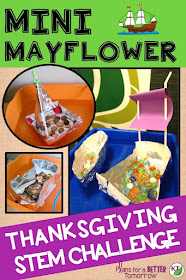Thanksgiving approaches, and with it, the first long-ish holiday of the year. Sometimes you can feel yourself dragging your battered legs to that finish line! Trying to keep kids engaged as they too approach a much-needed rest can be a huge challenge. This is why I love STEM challenges so much. They're naturally enjoyable activities that are chock full of academic rigor (when done properly/with intent).
Over the coming weeks, I will be describing five (5) Thanksgiving challenges that follow the needs encountered by travelers setting up a new settlement:
- Mini Mayflower (Get to where you're going)
- Protect-a-Pilgrim (Build a shelter)
- Pumpkin Picker (Gather available food)
- Corn Cultivator (Set up sustainable food source)
- Turkey Transporter (Once all major needs are met, there's time for fun!)
This week, we're heading over to the New World with Mini Mayflower!
Premise:
Students design a boat built for capacity and/or speed. Capacity can be measured in any uniform object: pennies, base ten blocks, candy pumpkins (warning: food can get messy if/when the ships sink), etc.
Where Can I Find Out More?
The video walk-through of Mini Mayflower is embedded below. In it, you'll find information about materials, modifying difficulty level, extensions and some tips & tricks to guide you, so you can better guide your students through the challenge. Check it out. However, if you prefer to read, you'll find the video transcribed at the end of this post.
Where are the Others?
 Patience, grasshopper! Good things come to those who wait. This is the first of five Thanksgiving challenges. Starting Oct. 20, I'll be posting one Thanksgiving STEM challenge video every Thursday to my YouTube channel and here on my blog.
Patience, grasshopper! Good things come to those who wait. This is the first of five Thanksgiving challenges. Starting Oct. 20, I'll be posting one Thanksgiving STEM challenge video every Thursday to my YouTube channel and here on my blog.Until then, you'll find the Thanksgiving bundle briefly described in this post.


All challenges are available individually and in discounted bundles in my TpT store, as well.
Video Transcription
Hi,
welcome to the first of five Thanksgiving Challenges. This is actually one of
my favorite series because each challenge leads into the next. I designed these
challenges to loosely mimic what the Pilgrims would have gone through when they
came to the New World. It goes step-by-step in their journey. The first
challenge that we'll talk about today in just a second is Mini Mayflower so
they had to get from the Old World to the New World. Once there, they have to
build a shelter. They need somewhere to live. That one's called
Protect-a-Pilgrim. Then they need to gather food. That would be Pumpkin Picker.
That leads into some more long-term planning.
They
need to learn to farm so they can have a sustainable settlement. That challenge
that goes with that is called corn cultivator. Now once all of these things are
in place, then there's a little bit of time for fun. That last challenge is
called Turkey Transporter. For today, let's get started on challenge one. We
need to get to the New World, Mini Mayflower. In this challenge, students will
build a boat built for capacity. You can also decide if you want to have them
build for speed. Before we get too far into the details, let's take a second to
look at the materials and the STEM challenge cycle. This is the STEM Challenge
Cycle you should follow for every challenge.
I've
defined each step in another video. You can click on the title now to see the
cycle explained. You're always welcomed to change up the materials however you
like. I just will recommend foil sheets for this one. It is a little bit
pricier to buy them in the pullout food prep sheets than it is in the roles,
but it's a lot simpler to distribute even amounts to every group. Let me just
caution you, don't give them too many materials on this or it will be very
difficult to sink those ships. So each of these boats was made with just one
foil sheet. If you have older students, you might want to even just give them
half of a foil sheet. You're going to need a little container for the boats to
float in.
Make
sure that they're deep enough so that the boats will actually sink if they hit
the bottom. The problem with this one is it's not quite deep enough. We'll see
if this one sinks or not but you can also use something with a little bit more
depth, something like this. Just hit the Dollar Tree. There's always a bunch of
stuff you can use. You're going to want some uniform objects in order to test
the capacity. I suggest marbles because they've got some good weight to them.
You'll be surprised at how much these boats can hold. You don't want to go with
anything too light like paper clips. You'll run out of paper clips for sure.
Base-ten-blocks, marbles, candies, pennies, that kind of thing.
Students
should place in one marble at a time so that it's easy for them to tell where
the failure point was once it does sink. Now if you run out of objects,
whatever your object is, before the boat sinks and you want to see how much the
boat can take, you can start using nonuniform objects. If you're going to do
that, you might want to try to have a scale on hand so you can get at least the
total weight of what the boat withheld before it failed. This one didn't fail
and I did run out of marbles so I would just keep adding, like I said, some
other objects. If you want to increase difficulty on this, you can add a speed
criterion so how fast can the boat actually travel.
Now,
it's very difficult to do this if you don't have a stream table like this. If
you take a look at it, my container is just barely larger than this boat so
you're going to need a larger container if you're going to want to test for
speed. One recommendation I do have is if you are going to test for both
capacity and speed, do the speed test first. Because what will happen is the
capacity test, you're basically testing until the boat fails. At that point,
you won't be able necessarily to test the speed. Another thing you can do if you
want to actually slow down the boats a little bit because maybe you don't have
a long enough stream table is to go ahead and put some weight in.
Ask
every group to put in 10 marbles and that should slow it down a little bit.
With the speed test, one of the things I like to do is to label the start line,
the Old World, and the finish line, the New World. The students are not allowed
to actually touch the boat once it's in the water with their hands, and I will
nudge it into place. In order to make the boat go, they would either need to
use wind or waves. I suppose there's a way to use maybe oars. I've just not
seen anyone do that yet, but the students would probably most likely use a
sail. You can decide whether or not you want to limit the members of the team
who are allowed to participate in making the boat go however they've designed
it to go.
Another
thing you can do to increase difficulty is ask each group to design two or more
boats and then either require them not to use the same base material. In this
one, I used foil for the base so in my second one I wouldn't be allowed to use
foil. I'd have to use something else that was providing the materials. Another
thing you can do, require that the base shapes be different. These two could
come from the same group because we have basically a canoe shape, and we have a
more of a rectangular prism. Although this is sort of close to a rectangle, you
can see it's pinched at the ends. Processions on this one, obviously they can
study the history of the Pilgrims coming over on the Mayflower.
Of
course from a science perspective, buoyancy, water displacement, Archimedes
principle, and then energy transfer through wind and waves. You have the basics
but if you want more than just the basics, check out the resource. This
resource contains everything you need to guide your students though the Mini
Mayflower Challenge including modifications for use with 2nd through 8th
graders. You'll still need to gather the simple materials of course, but the
rest has been done for you. You'll get Aligned Next Generation Science
Standards. Links to my STEM challenge How-to videos help you get the most from
each challenge and the Mini-Mayflower Materials list.
In
Teacher Tips, you'll find premise and setup, how to increase or decrease
difficulty through the Criteria and Constraints list, measuring results and
cross-curricular extension suggestions. You'll find two versions of editable
Criteria and Constraints list so you can tailor the challenge to your students.
For Student Handouts, there are two versions, four-page expanded room for
response for younger students and a two-page condensed space paper saver
version. You'll also find a set of group discussion questions. In the Extension
Handouts, you'll find math extension and process flow templates.
This
resource is available individually and bundled with Boat Building which
includes Mini Mayflower, as well as a second version that dives deeper into
data and design analysis in using the scientific method. You'll also find Mini
Mayflower as part of the discounted Thanksgiving and Mega STEM Challenge
Bundles. Links can be found in the description below the video. Thanks for
joining me on our first week. Please don't forget to like and describe. Next
week, we'll be back with Protect-a-Pilgrim.




No comments:
Post a Comment